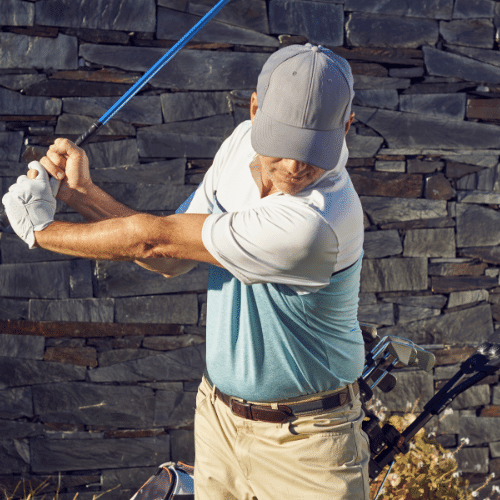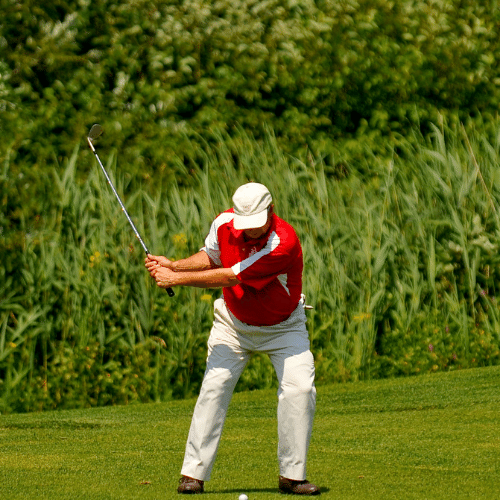Bowed left wrist downswing and how this simple thing can effect your golf game, Are you frustrated with your golf game, constantly dealing with slices and inconsistency? Imagine if your drives were straight and your iron shots were on target every time. Well, achieving this dream is possible by mastering the optimal wrist position in your golf swing.
The position of your wrists during the swing can have a significant impact on the outcome of your shots. In this article, we will explore different wrist positions and their advantages and disadvantages. By understanding and implementing the correct wrist position, you can unlock the key to greater success on the golf course.
Key Takeaways For Bowed Left Wrist Downswing ?
Wrist Position Impact:
- Cupped leads to slices; bowed reduces slices.
- Crucial for a consistent, accurate swing.
Understanding Positions:
- Flat for compression, straight shots.
- Bowed for shallower path, less slices.
- Cupped results in open face, poor contact.
Flat Wrist Pros and Cons:
- Benefits: Better compression, straight shots.
- Drawbacks: Excessive flatness may cause hooks.
Correcting Cupped Wrist:
- Leads to steep downswing, poor contact.
- Strengthen grip, use aids for correction.
Mastering Bowed Wrist:
- Crucial for accuracy.
- Avoid tight grip, practice drills.
- Use aids like wrist braces for control.
Importance of Proper Wrist Position
Proper wrist position is crucial in golf for achieving a consistent and accurate swing. Many golfers make common mistakes with their wrist position, often underestimating the importance of their grip.
The position of your wrists can greatly impact your swing mechanics and the flight of the ball. One common mistake is having a cupped left wrist at the top of your swing, which can result in an open clubface and slices. On the other hand, a bowed left wrist promotes a closed clubface and a shallower club path.
Strengthening your left-hand grip can help correct a cupped wrist, while adjusting your grip and using training aids can assist in achieving a bowed wrist position. By focusing on maintaining proper wrist position, you can improve the consistency of your swing and reduce the risk of errant shots.
Understanding the Different Wrist Positions
Understanding the different wrist positions in golf is crucial for improving your swing mechanics and ball flight. Let’s take a closer look at the three common wrist positions: flat, bowed, and cupped.
- Flat lead wrist: In this position, the left wrist is in a neutral, flat position at the top of the swing. It enables forward shaft lean, better ball compression, and straighter shots.
- Bowed: The left wrist is slightly bowed, with the clubface pointing towards the sky. This position promotes a shallower club path, straightens out ball flight, and reduces slices.
- Cupped: In this position, the left wrist is arched with the back of the hand facing the sky. It results in an open clubface, steep downswing, and poor contact with the ball, often due to improper wrist conditions at the top of the backswing.
By understanding these different wrist positions, you can avoid common mistakes and improve your golf swing. Incorporating specific drills into your practice routine can help develop muscle memory and promote the correct wrist positions throughout the swing. Seeking professional guidance for grip adjustments can also be beneficial.
Benefits and Drawbacks of a Flat Wrist

Having a flat wrist in your golf swing has its advantages and disadvantages that can greatly impact your performance on the course. Let’s take a look at the benefits and drawbacks of having a flat wrist:
Advantages:
- Improved ball compression and straighter shots: A flat wrist allows for better contact with the ball, resulting in improved compression and straighter shots.
- Easier unwinding on the downswing and getting hands ahead of the ball at impact: With a flat wrist, it’s easier to unwind your swing and get your hands in front of the ball at impact, which can lead to better accuracy and distance.
- Promotes forward shaft lean: Most golfers aren’t familiar with the position of forward shaft lean, but a flat wrist promotes this position just like Dustin Johnson, which can help improve your swing dynamics and ball striking.
Disadvantages:
- Too much flatness can cause a hook: While a flat wrist can be beneficial, excessive flatness can cause a hook, where the ball curves excessively to the left (for a right-handed golfer). Finding the right balance with a flexible wrist, akin to Jon Rahm, is crucial. to avoid this issue.
- Finding the right balance is crucial: It may take time to adjust to a new grip and get used to the change in wrist position. Finding the right balance between a flat wrist and a natural grip is important for consistency in your swing.
- Adjusting to a new grip and getting used to the change may take time: Changing your grip to accommodate a flat wrist may require some practice and adjustment. It’s important to be patient and gradually adapt to the change to improve your golf swing.
Correcting a Cupped Wrist Position
Improving your golf swing involves addressing various aspects. One important factor to focus on is correcting a cupped wrist position.
A cupped wrist can result in a steep downswing and poor contact with the ball. To rectify this issue, start by examining your grip. A weak left-hand grip is often the primary cause of a cupped left wrist.
Strengthening your left-hand grip can assist in squaring the clubface and promoting a more neutral wrist position. Additionally, incorporating training aids can be advantageous in correcting a cupped wrist.
These aids offer feedback and help develop the necessary muscle memory for a proper wrist position. By adjusting your grip and utilizing training aids, you can enhance your ball flight and overall golf performance.
Mastering the Art of a Bowed Wrist
To improve your golf swing and achieve better ball flight and accuracy, it’s important to master the technique of a bowed wrist. Developing wrist flexibility, like Jon Rahm’s, at the top of the backswing is crucial for this skill.
Avoid making these common mistakes in wrist positioning:
- Avoid gripping the club too tightly, as this can hinder your ability to effectively bow the wrist.
- Make sure to prevent the wrist from collapsing during the backswing, as this can lead to a flat or cupped position.
- Be cautious of over-bowing the wrist, as this can result in a hook and inconsistency in your swing.
To master the art of a bowed wrist, focus on maintaining a firm yet relaxed grip. Practice drills that promote wrist flexibility and control. You can also use training aids like wrist braces or alignment sticks to help achieve the correct position.
With patience and dedication, you can improve your golf swing, straighten out your ball flight, and lower your scores.
Tips for Improving Wrist Position in Golf

To improve the position of your wrists in golf, focus on maintaining a neutral grip and practicing drills that promote proper alignment.
One common mistake is cupping the left wrist at the top of the swing, which can lead to an open clubface and slices. To correct this, strengthen your left-hand grip and use training aids that encourage a bowed wrist position.
Another mistake is having a flat right wrist at impact, which can result in inconsistent shots. To address this, work on maintaining a slight bow in your right wrist throughout the swing.
Regularly practicing drills for wrist positioning and seeking professional guidance for grip adjustments will help you improve your wrist position in golf and enhance your performance on the course.
Slicing Woes? Discover the Art of Precision: Mastering Optimal Wrist Positions in Your Golf Swing
Are you struggling with slices and inconsistency in your golf game? This article emphasizes mastering optimal wrist positions for straighter drives and precise iron shots. Understanding positions like flat, bowed, and cupped wrists is crucial for improving your swing. Explore the benefits and potential pitfalls of having a flat wrist, correct a cupped wrist position, and master the technique of a bowed wrist. If slicing is a concern, check out a guide on “How to Stop Slicing Your Driver” for additional tailored tips and solutions.
FAQ For Bowed Left Wrist In The Golf Swing
Q: How does the position of the wrist in a golf swing affect the ball’s trajectory?
A: The wrist position, particularly the lead wrist in the golf swing, significantly affects the ball’s trajectory. When the wrist bows or flexes at the top of the downswing, it promotes a shallow swing plane, ideal for achieving a low spin, penetrating ball flight. In contrast, if the wrist extends or bends backward, it can lead to a steeper swing and higher ball flight.
Q: Can someone with a neutral golf grip achieve the bowed left wrist at the top technique?
A: Yes, someone with a neutral golf grip can still achieve that bowed left wrist position at the top of the swing. The essential element is for the golfer to focus on flexion in the downswing. However, using a slightly stronger left-hand grip might make reaching the bowed position simpler. As always, harmonizing the grip with your swing and wrist position is the best matchup.
Q: Is it possible to overdo the bowing of the left wrist during a golf swing?
A: Yes, it is possible to overdo the bowing of the left wrist, leading to a “shut” clubface at impact and resulting in a ball flight too far to the left. It’s essential to find the optimal balance of bowing that delivers power while ensuring accurate shots.
Q: What’s the correlation between wrist movements and ulnar and radial deviation in the golf swing?
A: In golf swing mechanics, wrist movements are often described in terms of ulnar and radial deviation. Ulnar deviation is when the wrist bends towards the little finger, a motion involved in achieving the bowed wrist at the top. Conversely, radial deviation, bending towards the thumb, is characteristic of the backswing. Both movements are key to maintaining proper wrist angles throughout the swing.

